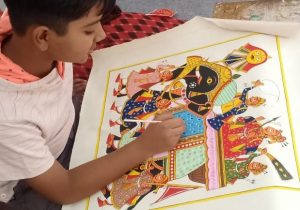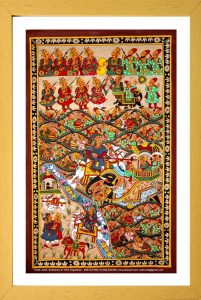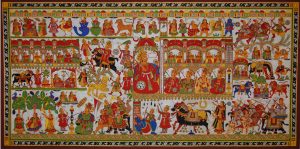700 years. 18 generations. One art form
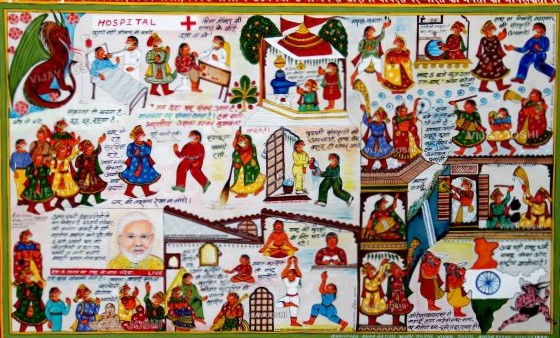
Saurabh Tankha
The next time you happen to be around the Pink City of Jaipur or visiting the heritage city of Ajmer, make sure to visit Shahpura. Located around 200 km from the state capital of Rajasthan and around 100 km from Ajmer, Shahpura falls in Bhilwara district and was once the jagir or estate of Surajmal, the second son of Maharana Amir Singh I who had the title of Raja Dhiraj. History notes that one of Surjmal’s two sons, Sujan Singh joined the service of Mughal emperor Shah Jahan who gave him the district of Phoolia and a mansab (military posting) of 800 foot soldiers and 300 horsemen. This happened in the earlier half of the 17th century. It was in 1629 that Shahpura became an independent state and was the second largest one in Mewar after Udaipur.
It is in Shahpura that the artform of Phad originate, around 700 years ago. Interestingly, the legacy has been passed down generations within one family. Phad is the art of storytelling through scroll paintings and songs highlighting local deities and gods, majorly a reincarnation of Lord Vishnu, Devnarayanji and a local folk hero, Pabuji Rathore.
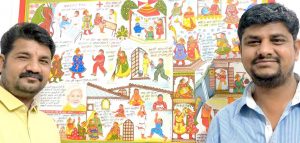
“To begin with, the stories about these heroes were sung without pictures by the members of the Rabari tribe called bhopas and bhopis. Back in those days, our ancestors used to make panchangs (a Hindu calendar and almanac which follows traditional units of Hindu timekeeping and presents important dates and their calculations in a tabulated form). One day, these bhopas and bhopis came to them and requested if they could make paintings based on these stories. ‘It would be easier to connect even with people who don’t know our language and understand our dialect,’ they said. Thus started the first audio-visual medium of entertainment,” informs traditional Phad artist Vijay Joshi, a 18th generation Phad artist, adding they call it chalta-phirta devra or travelling temple. While the phads of Pabuji are around 15 ft long, the phads of Devnarayanji are around 30 ft long.
Vijay, like his father, National Award winner Shanti Lal Joshi and most of his forefathers, started learning the art before turning 10. Same with his brother, Vivek. In fact, Vijay’s 11-year-old son, Atharv and 14-year-old daughter, Anushka have already started learning the artform.
Strangely, Anushka’s generation is perhaps one of the first ones to be holding the canvas and brush in her hands. Before that, except for getting to draw the first line on the canvas, unmarried girls were not trained in creating a Phad painting. It was an age-old tradition which he says represented shakti. “However, learning of the art was limited to daughters-in-law but not daughters. We had heard from our elders that ‘hum aanewali ko sikhate hain, jaanewali ko nahin meaning we teach it to girls coming in the family after marriage and not to the ones going away after marriage’. But I made sure my daughter learns it the same way as my son,” says the 42-year-old artist.
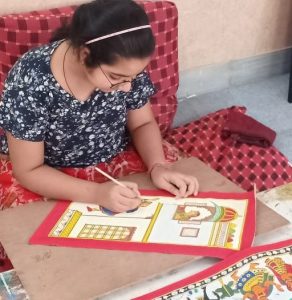
How is a Phad made? “A thick homemade parchment type two ply cloth is used to make Phad paintings. We then do charak (which works as a starch and cleans the cloth too) period) thereafter to increase its life. Then, we have an old stone on which the cloth is rubbed to soften and smoothen it. This is in the form of a manual machine. The colours are made out of stones which are crushed over months before the final colour is achieved. It can take up to three months to get the final colour,” shares the artist. He adds that this process increases the durability and can last up to 200 years. “Mercury,” he says, “is mixed to get smoother consistency. It is a natural process as originality needs to be maintained.”
How much time does it take to make a Phad? “It can take up to three months to create a painting single-handedly,” says Vijay. And what about the price? “Depending on the size and intricacy of the work involved, it could be priced anywhere between Rs 20,000 to Rs 10 lakh,” he adds.
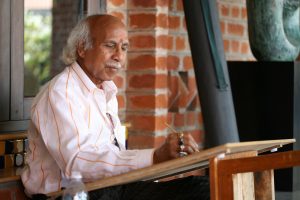
Ask him if Phad artists are happy with the schemes and policies the government introduces at regular intervals for their welfare and Vijay says, “To recognise the right person, whether he is a genuine Phad artist or not, more stringent measure should be introduced,” he says, remembering the days when the exercise was tougher to identify the real artist. “When an artist submitted his works for authentication, a few of his works were picked up by unknown people from his place. These were then taken and matched with works submitted by the artist. The artist was then called to the office and he had to create an artwork in front of them. Only the genuine artists passed the litmus test,” explains Vijay, adding that now, anyone can just walk in and claim to be an artist as no matches are done.
The best way to find out a fake from a real Phad artwork is the shade of the colours used in a painting. “An original will always have subtle, dull and light colours as naturals are always duller. Artificial ones will always be brighter,” he puts in.
The artworks of the Joshis have been appreciated by millions across the world and don the walls of many a celebrities with the most notable one being Amitabh Bachchan. “We create paintings on the story of their lives. Other celebs include Sanjay Dutt, Salman Khan, Ratan Tata, Dhirubhai Ambani and many more,” says Vijay. Most recently, the two brothers made a Phad on the current Covid-19 situation. “We did it without having a wink of sleep over two days,” shares Vivek.


